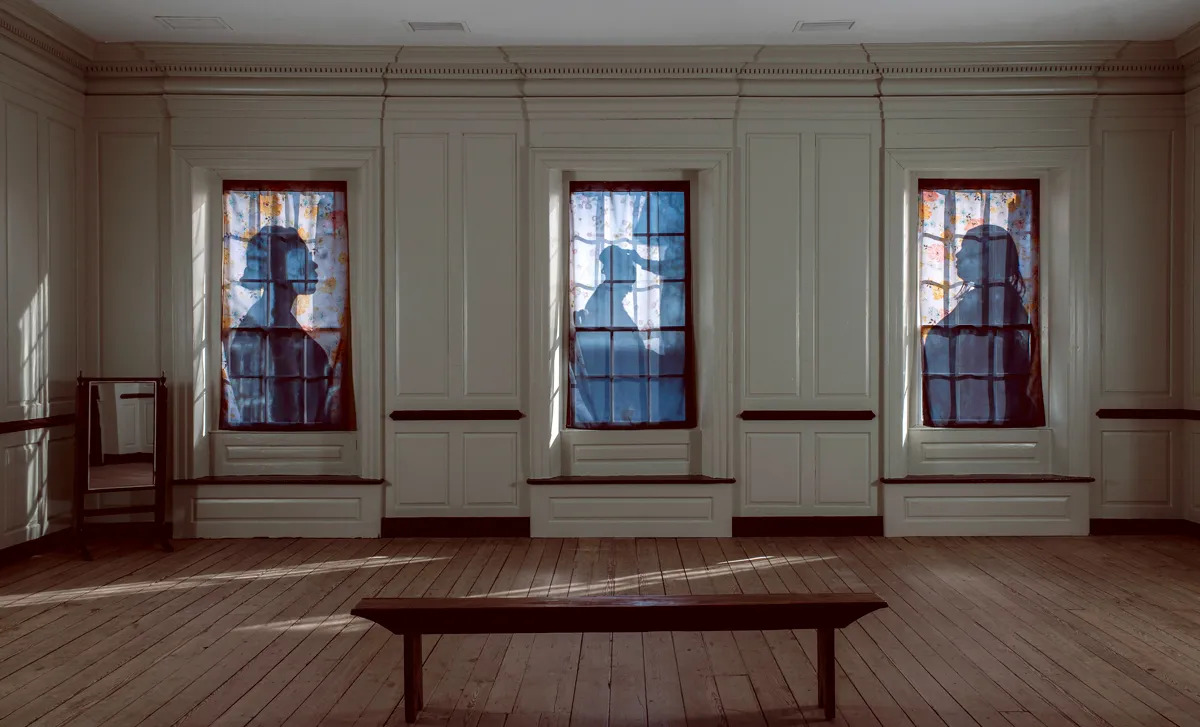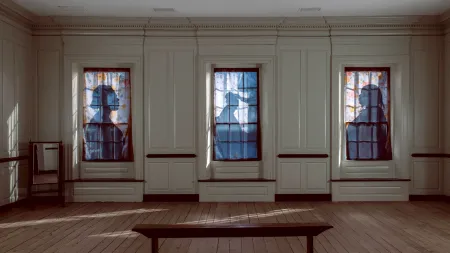
Resting in the windowsills of the 1767 Chowan County Courthouse in Edenton, North Carolina, are the silhouettes of women appearing behind sheer floral curtains; their profiles overlook the large, closed doors of the two-story courthouse. Two Black women, Michelle Lanier and Johnica Rivers, approach the building with their hands clasped together as a larger group of 70 Black women trail behind them. Together, they walk the long, verdant lawn that extends from the shores of Edenton Bay to the courthouse.
The women are guided by the voice of singer Lois Deloatch, who soulfully intones:
I’ll fly away
To a land where joy shall never end
I’ll fly away
I’ll fly away, oh, Glory
I’ll fly away
When they reach the top of the courthouse steps, Lanier extends her hand above her head and, with a closed fist, she knocks on the door twice. She waits briefly, stretching her fingers as she presses her open hand against the door’s surface; immediately the courthouse bell tolls as the two 12-foot-tall doors swing open to a gentleman welcoming the group of women into one of the oldest courthouses in the United States.
The 1767 Chowan County Courthouse is the site of an installation, Memorable Proof, by artist Letitia Huckaby that is part of the “Harriet Jacobs Project,” an ongoing initiative directed by Lanier and curated by Rivers. Collectively, their work is dedicated to the memory of Harriet Jacobs, author of Incidents in the Life of a Slave Girl, a trenchant autobiographical account of her enslavement in Edenton and escape to freedom. Jacobs wrote the book under a pseudonym Linda Brent, in 1860, revealing the harrowing details around the mental, physical, and sexual abuse she suffered from her de facto owner, Dr. James Norcom, whose torture she fled, hiding in a small garret in her grandmother’s home for seven years.

While Incidents was lauded within abolitionist circles upon its publication, it eventually drifted into obscurity for about a century. Historian Jean Fagan Yellin eventually resurrected the book’s legacy, proving the work was not a fictional account as was long believed. She conducted extensive archival research to conclusively link Jacobs to her writing and her subsequent abolitionist work in the postbellum North and South, publishing the biography Harriet Jacobs, A Life in 2004.
In 2006, Lanier, director of North Carolina Historic Sites, learned of Yellin’s scholarship, and began pursuing a unique activation dedicated to Jacobs’s legacy. At the time she was the organization’s curator of cultural history, and in 2008, Lanier organized a book release event in Edenton for Yellin’s publishing of the Harriet Jacobs Family Papers. As Lanier recounted in a 2008 article with UNC Press, “One of my goals as a public historian is to help create spaces where visitors can experience emotional impacts, discover connections to the past, or have epiphanies of historic relevance. In such moments, an internal bell rings out in the face of human experience preserved in the amber of historic preservation.” Since the 2008 launch, Lanier has picked up the baton of this historical stewardship from Yellin, and she is now passing the curatorial baton to Johnica Rivers to ensure that the memory of Jacobs is indelibly tied to Edenton.
With Memorable Proof, Huckaby and Rivers activated the historic courthouse using a combination of photography and textiles to create portraits of members of the Fannie A. Parker Woman’s Club, an Edenton-based civic organization founded in 1909 by Black women under the National Association of Colored Women’s Clubs, established 13 years earlier in 1896. To create these silhouetted portraits, Huckaby photographed Edenton chapter members on location, placing them behind a floral sheet as she shot the images, later printing them on sheer panels of flag fabric. In the windows of the courthouse, her subjects appear like ethereal apparitions. The sheerness of the fabric lets in light that reveals the gridlines from the windowpanes and the views outside, giving the work a layered, palimpsestic feel.

Rivers said she envisioned Memorable Proof as a “site responsive” installation: the silhouettes’ placement above the judge’s bench, lining the courthouse’s semicircular apse, evokes the exalted reverence of saintly figures memorialized in the stained-glass windows of a church. Here, she situates the women with a regal presence that centers their status as community caregivers and historical caretakers. This site holds important familial connections to Jacobs; her grandmother, Molly Horniblow, secured her freedom in this courtroom, and as a manumitted woman, Horniblow bought the Edenton home that concealed her enslaved granddaughter for seven years.
Memorable Proof is part of a larger activation of Jacobs’s hometown, organized by Lanier and Rivers who have created a cultural experience through a series of artistic interventions. Titled A Sojourn for Harriet Jacobs, the pair brought together an interdisciplinary group of women who have studied, written about, or invoked the memory of Jacobs within their academic, artistic, and cultural work. The inaugural Sojourn activation encouraged a deeper engagement with research materials and ideas that artists and writers draw upon in their work. Addressing the group over dinner one night this past March, Rivers said of their mission: “What we are embodying here is land as source material. It is not enough to go into the archives. You need to go to the place.”

With the Sojourn for Harriet Jacobs project Lanier and Rivers draw upon Joseph Beuys’s concept of social sculpture, positing the idea that everything is art and that art can be used to transform society. Analogous activations include Rick Lowe’s development of Project Row Houses, in which artists are invited to create work within the context and community of Houston’s historically Black Third Ward. For Sojourn, the duo have created an environment in which artists work in concert with the community and visitors to that community to realize the final works.
Lanier and Rivers approached this unique curatorial project by asking themselves, “How do we reveal the hidden markers of their lives on the land?” They created an experience akin to a close read of Incidents by highlighting elements of Jacobs’s life alongside her historical context as a way to bring her story to life and deepen the community’s connection to her life’s work.
“It has been painful to me, in many ways,” Jacobs writes in Incidents, “to recall the dreary years I passed in bondage. I would gladly forget them if I could. Yet the retrospection is not altogether without solace; for with those gloomy recollections come tender memories of my good old grandmother, like light, fleecy clouds floating over a dark and troubled sea.”

During our own sojourn to Edenton this spring, Lanier and Rivers took the group to the Providence Burial Ground where Horniblow and Jacobs’s mother and father are all interred. Along a nearby creek bed, volunteers handed out white rose petals from baskets for guests to cast into the slow-moving current as church bells peacefully rang in the distance. It was a moment of quiet reflection and meditation as we called upon the memories of loved ones who have traveled into other realms. The intense emotions conjured throughout the day prompted tears of sorrow and joy as friends and strangers alike comforted one another as we traversed the land and the profound sensations of grief, loss, gratitude, and hope.
To quote Jacobs, “The dream of my life is not yet realized. I do not sit with my children in a home of my own, I still long for a hearthstone of my own, however humble. I wish it for my children’s sake far more than for my own.”

Sojourn itself asks participants what it means to be called to the hearthstone of someone they’ve never met, to break bread with them, to walk the land they once trod, to smell their favorite spring flowers, to gaze upon the waters that set them free, to raise a glass in their honor.
For Lanier and Rivers, the goal of Sojourn for Harriet Jacobs is to embody the care to community that its namesake gave to Edenton, with the goal of making sure Jacobs is never forgotten again. Back in the courthouse, tucked in a small vestibule on the second floor is a fireplace with a vintage Victorian-era pole screen next to it. Above the hearth is a photograph of Harriet Jacobs, seated in a large gothic Victorian parlor chair boasting a slight upturned grin, welcoming us to her very own hearthstone.
Has the Bienal FEMSA, the Crown Jewel of Mexico’s Art Scene, Become Too Sprawling for Its Own Good?
LC Queisser Gallery Is Bringing Georgian Art to the World

This Hamptons Home Was Once Embroiled in a Feud Between High-Powered Neighbors. Now It’s Listed for $37 Million.

Best Dressed at the Prelude to the Olympics at Fondation Louis Vuitton: Zendaya, Tyla and More

11 iOS 18 features that’ll only be available on newer iPhone models

France Aims for Record Medal Haul Thanks to de Gaulle’s Disgust


